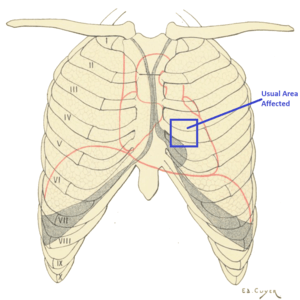Precordial catch syndrome
| Precordial catch syndrome | |
|---|---|
| Synonyms | Texidor's twinge[1] |
 | |
| One of the areas more commonly affected in precordial catch syndrome[1] | |
| Specialty | Pediatrics, family medicine |
| Symptoms | Sharp, stabbing chest pain in a small area[1] |
| Usual onset | Sudden[1] |
| Duration | Less than 3 minutes[1] |
| Causes | Unclear[1] |
| Diagnostic method | Angina, pericarditis, pleurisy, chest trauma[1] |
| Treatment | Reassurance[1] |
| Prognosis | Good[1] |
| Frequency | Relatively common[1] |
Precordial catch syndrome (PCS) is a non-serious condition in which there are sharp stabbing pains in the chest.[1] These typically get worse with breathing in and occur within a small area.[1] Spells of pain usually last less than a few minutes.[1] Typically it begins at rest and other symptoms are absent.[1] Concerns about the condition may result in anxiety.[1]
The underlying cause is unclear.[1] Some believe the pain may be from the chest wall or irritation of an intercostal nerve.[1][2] Risk factors include psychological stress.[2] The pain is not due to the heart.[1] Diagnosis is based on the symptoms.[1] Other conditions that may produce similar symptoms include angina, pericarditis, pleurisy, and chest trauma.[1]
Treatment is usually via reassurance, as the pain generally resolves without any specific treatment.[1] Outcomes are good.[1] Precordial catch syndrome is relatively common, and children between the ages of 6 and 12 are most commonly affected.[1] Both males and females are affected equally.[1] It is less common in adults.[2] The condition was first described in 1955.[1]
Signs and symptoms
PCS has consistent characteristics. Its symptoms begin with a sudden onset of anterior chest pain on the left side of the chest. The pain is localized and does not radiate like heart attack pain typically does. Breathing in, and sometimes breathing out, often intensifies the pain. Moving also intensifies the pain. Typically this causes the patient to freeze in place and breathe shallowly until the episode passes. Episodes typically last a couple of seconds to three minutes. In some cases it lasts for 1 hour. The frequency of episodes varies by patient, sometimes occurring daily, multiple episodes each day, or more spread out over weeks, months, or years between episodes. PCS is believed to be localized cramping of certain muscle groups. Intensity of pain can vary from a dull minor pain, to intense sharp pain possibly causing momentary vision loss/blurriness and often loss of breath.
Causes
The underlying cause is unclear.[1] Some believe the pain may be from the chest wall or irritation of an intercostal nerve.[1][2] Risk factors include psychological stress.[2] The pain is not due to the heart.[1]
Treatment
There is no known cure for PCS; however, PCS is not believed to be dangerous or life-threatening. Many see the worst part about PCS to be the fear that this chest pain is an indicator of a heart attack or other more serious condition. As the condition is not dangerous or life-threatening, there is no reason to take medication, although some sufferers may choose to refrain from some normal activities such as physical exercise, as this can exaggerate the pain, particularly if it occurs during physical activity.
While there is no known cure, some patients have reported relief after slowly inhaling and holding their breath for a short while. Also, lifting the elbows while in an upright position reportedly decreases pressure on the region. Keeping the body hydrated is reported to decrease the frequency of these episodes as well, and ibuprofen may also help.
History
The syndrome was first described and named in 1893 by Henri Huchard,[3] a French cardiologist, who called it "précordialgie" (from the latin "praecordia" meaning "before the heart"), or "Syndrôme de Huchard" ("Huchard syndrome").[4][5] The term "precordial" had entered the French medical lexicon with the 1370 translation of Guy de Chauliac's Chirurgia magna.[6] Previously, the Latin term "praecordia" had been used to refer to the diaphragm, a sense now obsolete.[6][7]
The Huchard syndrome was then studied more deeply by Miller and Texidor, medical practitioners at the Cardiovascular Department and the Department of Medicine at the Michael Reese Hospital in Chicago, in 1955.[8] They reported the condition in 10 patients, one being Miller himself. In 1978, PCS was discussed by Sparrow and Bird who reported that 45 healthy patients suffered from it and that it was probably more frequent than generally assumed.[9] PCS in American children has been discussed by Pickering in 1981[10] and by Reynolds in 1989.[11] These constitute the literature available in English on PCS.
See also
References
- 1 2 3 4 5 6 7 8 9 10 11 12 13 14 15 16 17 18 19 20 21 22 23 24 25 26 27 28 Gumbiner CH (January 2003). "Precordial catch syndrome". Southern Medical Journal. 96 (1): 38–41. doi:10.1097/00007611-200301000-00011. PMID 12602711.
- 1 2 3 4 5 McMorran, Jim. "Precordial catch syndrome (PCS)". General Practice Notebook. Retrieved 2 January 2018.
- ↑ http://gallica.bnf.fr/ark:/12148/bpt6k54958171/f732.item.r=Pr%C3%A9cordialgie.zoom
- ↑ http://gallica.bnf.fr/ark:/12148/bpt6k57064606/f201.image.r=Henri%20Huchard%20pr%C3%A9cordialgie
- ↑ https://archive.org/stream/traitcliniqued02huch#page/198/mode/2up/search/Pr%C3%A9cordialgie
- 1 2 "précordialgie". Centre National de Ressources Textuelles et Lexicales.
- ↑ "praecordia". Oxford Dictionaries.
- ↑ Miller, A.J.; Texidor, T.A. (December 1955). "Precordial catch, a neglected syndrome of precordial pain". Journal of the American Medical Association. 159 (14): 1364–5. doi:10.1001/jama.1955.02960310028012a. PMID 13271083.
- ↑ Sparrow MJ, Bird EL (October 1978). "'Precordial catch': a benign syndrome of chest pain in young persons". The New Zealand Medical Journal. 88 (622): 325–6. PMID 282484.
- ↑ Pickering D (May 1981). "Precordial catch syndrome". Archives of Disease in Childhood. 56 (5): 401–3. doi:10.1136/adc.56.5.401. PMC 1627421. PMID 7259265.
- ↑ Reynolds JL (October 1989). "Precordial catch syndrome in children". Southern Medical Journal. 82 (10): 1228–30. doi:10.1097/00007611-198910000-00007. PMID 2678498.
External links
| Classification |
|---|